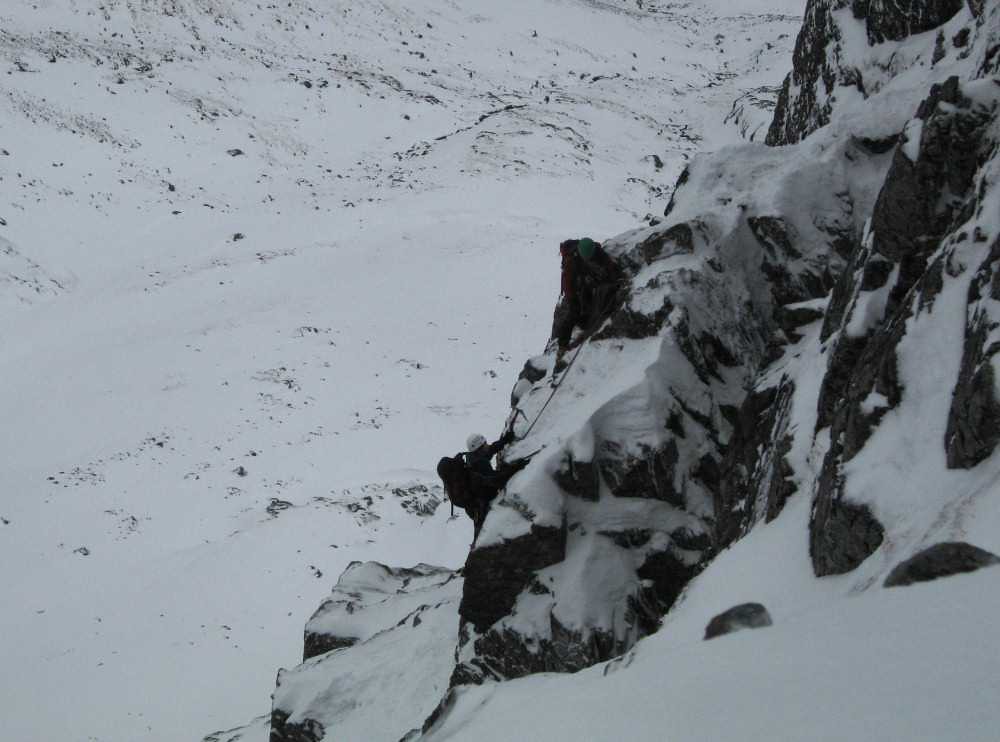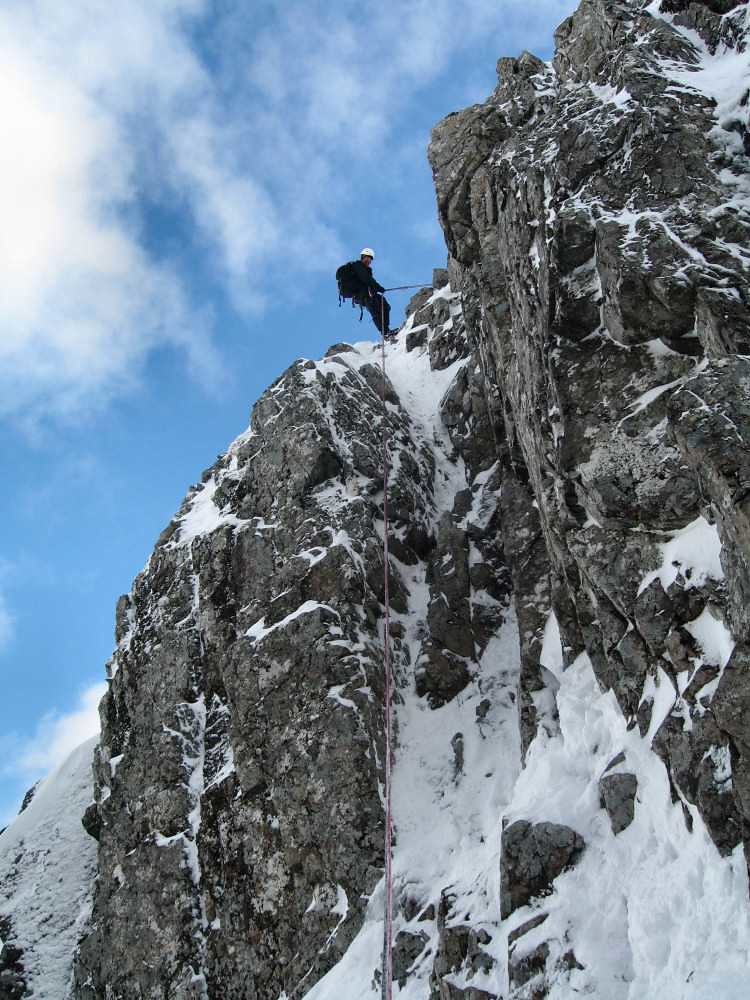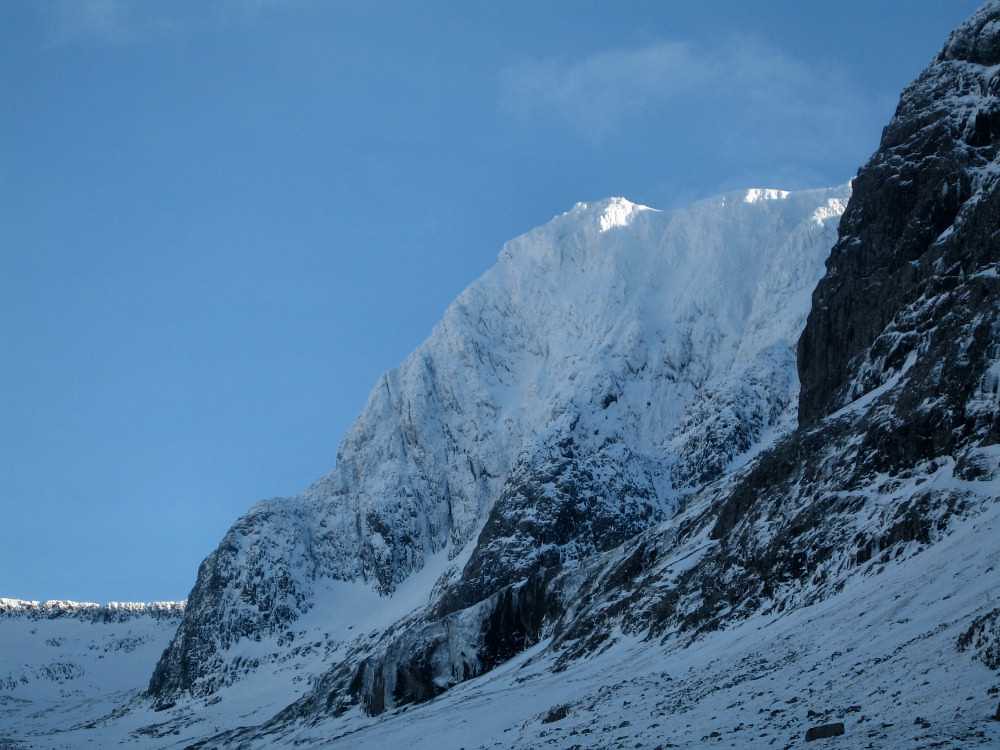or route finding on a popular V Diff
My very first proper rock climb was Grooved Arête on Tryfan. My first lead had
been a supervised pitch two on that same climb. This Easter, I returned with
Martin’s mate, Dave. Dave’s only ever been to North Wales
once before, and that was the scene of an off-route and wet epic with me on the
nearby Sub Cneifion Rib. So now was a chance to do a classic route, with no
worries about route finding. We converged on the start of the route exactly as
two other teams arrived. Thankfully, we got away second in the queue, me leading
the first pitch. At the top of the first section, I looked at a crack continuing
straight up, but decided it was harder than the grade of the climb, and craftily
placed a friend in it before stepping left to find the polish on the rib. Dave,
with that one lonely placement as a guide, and no useful advice from his belayer
climbed said crack direct, in, it has to be said, good style.
The first pair up had gone straight up on the next pitch, only stepping to the
left near the top. The guide book and my memory told me that this wasn’t the
route, that in fact one should step directly into the groove in the rib to the
left. I only worked this out after Dave had made some progress off route, so he
made an awkward traverse left, gaining the rib with a very bold step from the
top of a pinnacle. Back on route, I led the remaining pitch before the path
across to the second half of the climb. At about this point, the party behind
lost touch with us, apparently a lack of confidence overcame the girl leading
the second pitch, as we later heard.
At this point, Dave was feeling rather cold, the sun having stayed hidden so
far, so I led the next pitch up the rib towards the ‘haven’. Now, this is where
the experience climber does a little arithmetic, since pitches on these classic
routes are often run together, as with first two pitches of the climb, for
example. So, the rib leads up one 90 foot pitch, to a block belay, followed by
another 120 foot pitch crossing a groove near the top to another grooved rib
before finally arriving at the haven. My rope being a mere 160 foot, I couldn’t
run these pitches together. After at most 50 feet of climbing, I came to a
plausible belay, but clearly this wasn’t it, so I carried on up the rib. As it
became clear that a) I’d climbed a lot more than 90 feet, and b) the rib was
getting harder, with no obvious holds above, I was forced to cross into the
groove on the left. A bit more progress, without anything resembling a decent
stance and things were starting to look pretty serious. Steep blank rock barred
all upwards progress. A delicate traverse back right to the arête showed nothing
but vertical featureless rock.
Looking back across the groove to the left, I spotted polish below me on the left
hand rib. Carefully, I eased my way back and rejoined the route with palpable
relief. Another few feet and I was able to belay comfortably.
My curious inability to keep to the polish on these classic routes has had me
wandering on previous occasions. I made a mental note to concentrate better in
future as I belayed Dave up to the stance, noticing the quite considerable rope
drag on the way. As it turned out, I’d used nearly a full rope length on that
pitch, so we deduced that Dave had about another 60 feet of climbing to reach
the haven. Dave set off, with strict instructions to ‘follow the polish’. He
quickly disappeared from view, somewhere over the buttress above my head. Soon,
another chap arrived, grunting as he hauled his rope up against what sounded
like a lot of drag. Still no news from above, as that pair got themselves
settled on an adjacent stance. We waited a bit. The very competent woman who’d
followed her husband up the previous pitch mentioned that this was, in fact, the
haven, and that the Ogwen guidebook was definitively wrong. “Ah”, I said. before
trying to communicate this important information to Dave, unsuccessfully.
Above the haven is a steep wall, surmounted by an exposed slab, which is normally
climbed diagonally up to the top right corner – the Knight’s Move. When,
eventually, Dave brought me up to his stance, I found him in a hanging belay at
the top left corner of the slab. I carefully traversed across to the hidden
niche where he would have been if only he’d realised what pitch he was on, and
brought him back to the route. In the meantime, the couple following us had come
through and combining with the next pitch, overtaken us. We were the second pair
that they’d overtaken, the pair immediately behind us at the start being the
first! Dave feeling the cold quite badly at this stage, I led the last pitch
out, only to be followed, somewhat rudely I felt, by another climber who’d
decided to climb on past Dave for reasons that weren’t clear to me at all. I
then brought Dave up whom had some difficulty, getting past the above mentioned
rope.
It was just another enjoyable day on a Welsh multi-pitch V Diff.



